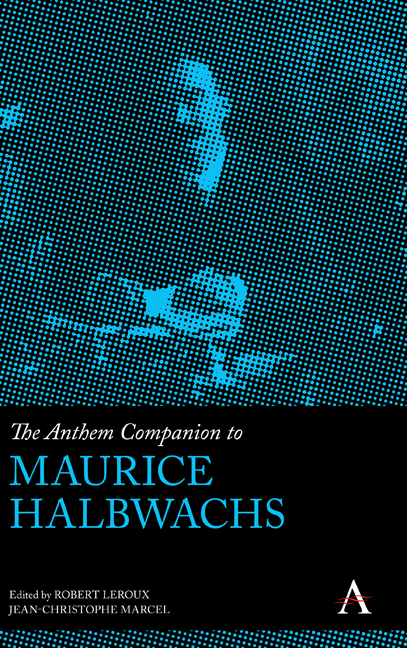Book contents
- Frontmatter
- Contents
- Introduction
- Chapter 1 A Theorist of Collective Memory
- Chapter 2 Halbwachs and the Durkheimian Perspective on History
- Chapter 3 Maurice Halbwachs, Sociologist of Memory: His Reception in Italy and the Development of the Sociology of Memory
- Chapter 4 Population as the Body of Society
- Chapter 5 Urban Morphology and Social Morphology: Marcel Roncayolo and the Work of Maurice Halbwachs
- Chapter 6 Halbwachs’s Leibniz and Halbwachs’s Sociology
- Chapter 7 Halbwachs on Quetelet and the Use of Statistics in Sociology
- Chapter 8 Maurice Halbwachs and the Sociology of Consumption and Social Classes
- Chapter 9 From Criticism of Moral to the Probalistic Test
- Chapter 10 The Age Criterion: Between Sociology and Biology
- Chapter 11 Speculation: Order or Disorder?
- List of Contributors
- Index
Chapter 4 - Population as the Body of Society
Published online by Cambridge University Press: 23 February 2022
- Frontmatter
- Contents
- Introduction
- Chapter 1 A Theorist of Collective Memory
- Chapter 2 Halbwachs and the Durkheimian Perspective on History
- Chapter 3 Maurice Halbwachs, Sociologist of Memory: His Reception in Italy and the Development of the Sociology of Memory
- Chapter 4 Population as the Body of Society
- Chapter 5 Urban Morphology and Social Morphology: Marcel Roncayolo and the Work of Maurice Halbwachs
- Chapter 6 Halbwachs’s Leibniz and Halbwachs’s Sociology
- Chapter 7 Halbwachs on Quetelet and the Use of Statistics in Sociology
- Chapter 8 Maurice Halbwachs and the Sociology of Consumption and Social Classes
- Chapter 9 From Criticism of Moral to the Probalistic Test
- Chapter 10 The Age Criterion: Between Sociology and Biology
- Chapter 11 Speculation: Order or Disorder?
- List of Contributors
- Index
Summary
Introduction
The importance Halbwachs gives to demographic facts can be understood in the light of his conception of social life, linked to a theory of the population seen as the body of society. His marked interest in the facts he describes as “morphological,” which appears relatively late as such in his bibliography (mainly the 1930s), enables us to specify the conception of the “social whole” that Halbwachs chooses to study collective life. Indeed, he uses a social ontology, in order to characterize society, which can be described as “organicist” and borrowed from Durkheim (Guillo and Marcel 2010). This topic – not very developed as far as the former studies tends to contrast Durkheim's sociology with organicist theories – allows us to expose a work that, at first glance, appears to be dispersed in several fields of research. It reveals that for Halbwachs societies can be considered as large moving bodies, which possess volume, material form, density, and mass. To define them, he uses the term “organism” or “organization.” In this sense, the “population facts” are not only biological and physical. They are social facts showing how society acts on its “body”: the group influences the actions of its members and contributes to shaping their habits, customs, tendencies, motives, and aspirations. Consequently, social stratification is to be understood in the same way: one of the means by which a society becomes more aware of itself and manages to maintain its integrity by organizing itself through an action of its body. “It is also, perhaps, by this organization of classes, and within it, that society succeeds best, at each epoch, in becoming conscious of itself, of what it is at that moment, and what it tends to be” (Halbwachs 2008, 254).
Thus, to perpetuate itself, any society develops within it an order of social relations, creates values, representations, and social feelings, and calls people to participate. One of the ways it has to do this is to organize division into classes, but also to have an action on births, deaths, nuptiality, and migratory movements.
- Type
- Chapter
- Information
- The Anthem Companion to Maurice Halbwachs , pp. 57 - 76Publisher: Anthem PressPrint publication year: 2021

